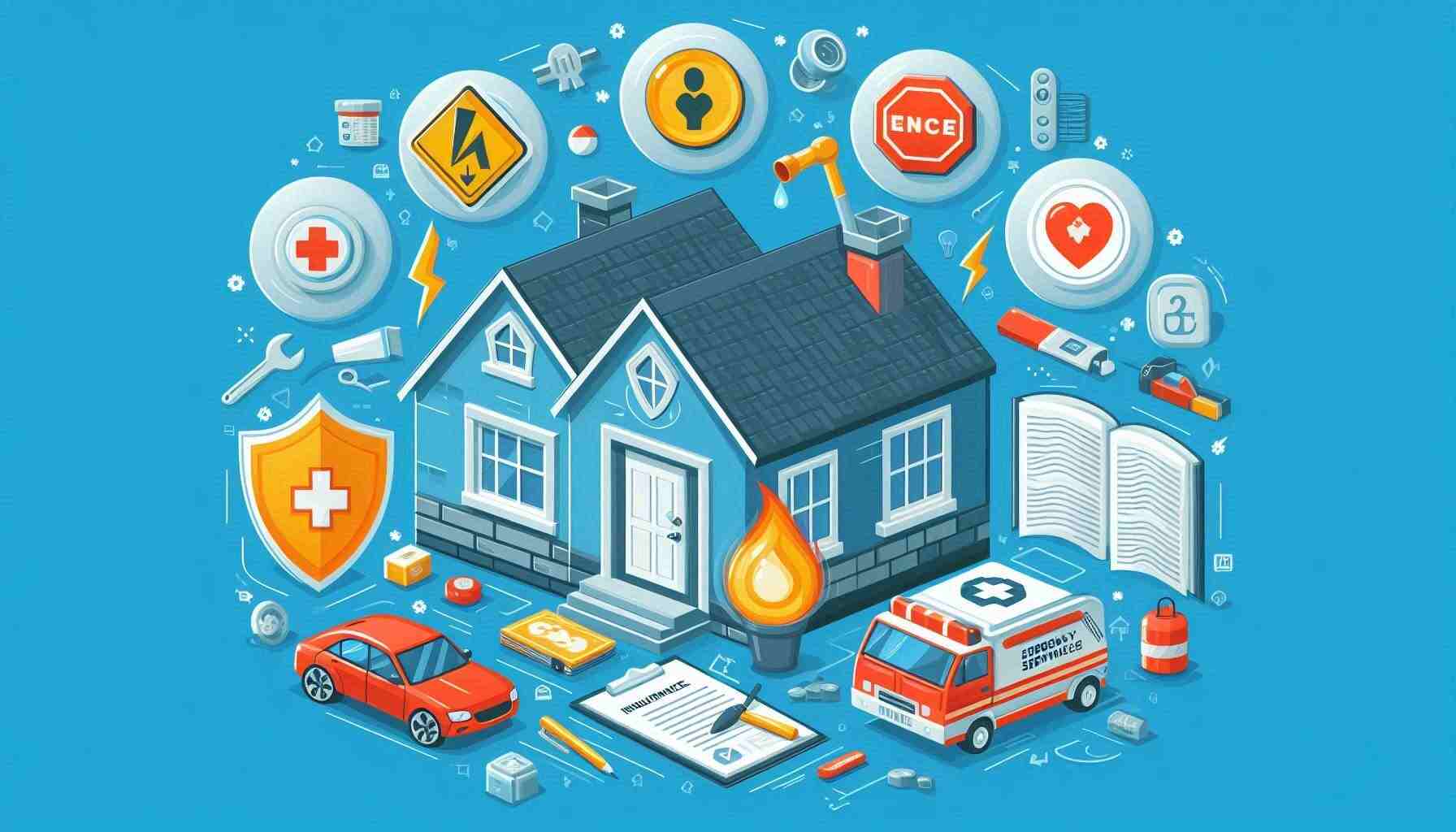Introduction: Understanding Homeowners Insurance Emergency Services Coverage
Selecting the right homeowners insurance emergency services coverage is a vital part of safeguarding your property against unexpected disasters. Imagine the stress of a burst pipe, fire, or severe storm—each of these events can disrupt life and potentially drain your finances if not covered adequately. Home insurance isn’t just about protecting walls and floors; it’s about preserving a place of safety for you and your family. In this guide, we’ll explore the 10 types of coverage you need in home insurance to ensure your home is fully protected in any emergency. Let’s dive into each type of coverage, so you can make informed decisions about your homeowner’s policy.

1. Dwelling Coverage: The Foundation of Home Insurance
At the heart of homeowners insurance emergency services coverage lies dwelling coverage. This coverage is the backbone of most home insurance policies, designed to cover the physical structure of your home. Dwelling coverage protects essential parts of your home—walls, roof, floors, and foundation—from various natural and man-made disasters. Imagine a fire damaging half of your house. With dwelling coverage, you won’t bear the entire financial burden of repairs or even rebuilding. Typically, the cost of dwelling coverage aligns with the estimated cost to rebuild your home. If your home is valued at $300,000, it’s wise to have dwelling coverage around that amount to cover the total repair costs. Here’s a snapshot of common incidents and potential repair costs:
| Incident | Average Repair Cost |
|---|---|
| Fire Damage | $10,000 – $50,000 |
| Wind/Storm Damage | $5,000 – $15,000 |
| Water Damage | $2,000 – $10,000 |
Dwelling coverage is crucial for any homeowner seeking a reliable financial safeguard in the face of natural or accidental damage.
2. Personal Property Coverage: Protecting What’s Inside
Personal property coverage extends beyond the structure of your home, covering essential belongings such as furniture, electronics, clothing, and appliances. Imagine you have a valuable collection of electronic devices or designer furniture. If they’re damaged in a fire or stolen during a break-in, personal property coverage would help you recover those items’ value. Coverage limits typically amount to 50%-75% of your dwelling coverage. For instance, if your dwelling coverage is set at $300,000, personal property coverage might range from $150,000 to $225,000. With personal property coverage, you’re securing the valuables that turn your house into a home.
3. Liability Coverage: Safeguarding Against Legal Claims
One often-overlooked part of homeowners insurance emergency services coverage is liability coverage. This type of coverage is invaluable for homeowners, as it protects against potential legal claims from injuries on your property. Let’s say a visitor slips on an icy walkway and sustains an injury. Without liability coverage, you could be held responsible for their medical bills and possibly additional legal costs. Most policies start with $100,000 in liability coverage, but experts often recommend increasing it to $300,000 or even higher if you have extensive assets to protect.
4. Additional Living Expenses (ALE) Coverage: Coverage for Temporary Living Costs
Disasters sometimes leave homes temporarily uninhabitable. Additional Living Expenses (ALE) coverage helps cover costs like hotel stays, meals, and other essentials when you’re displaced. For instance, if a kitchen fire makes it impossible to cook or sleep in your home, ALE would cover the expenses for alternative accommodations. Here’s a breakdown of some typical expenses covered by ALE:
| Expense | Typical Coverage |
|---|---|
| Hotel Stays | Up to $200 per night |
| Restaurant Meals | Up to $50 per day |
| Laundry Services | Up to $20 per week |
ALE coverage can vary widely depending on the insurer, but it’s a critical part of ensuring that life goes on as smoothly as possible in difficult times.
5. Medical Payments Coverage: Quick Financial Relief for Minor Injuries
Medical payments coverage offers another layer of security by covering minor injuries to guests on your property, regardless of who is at fault. If a friend or neighbor suffers a minor injury, like a sprained ankle, medical payments coverage handles their immediate medical expenses without a lengthy claims process. Coverage limits typically range from $1,000 to $5,000. This can be a reassuring addition to your policy, as it shows goodwill and helps prevent further disputes.
Read More:
- How 3.5 Miles from Coast Reduce Home Insurance Cost
- Big One Home Insurance: A Smart Choice for You
- How to Choose the Right Illinois Home Insurance
6. Water Damage and Sewage Backup Coverage
Water-related incidents, like pipe bursts or sewer backups, are common yet costly home emergencies. Standard homeowners insurance emergency services coverage often excludes damage from sewage backups, so adding this coverage can be critical. Water damage coverage helps handle repair costs for broken plumbing, leaks, or overflowing sewage systems, reducing financial strain.
Why It’s Essential
Unanticipated water damage can cause mold growth, structural damage, and other long-term issues. Here’s a quick look at repair costs:
| Issue | Average Repair Cost |
|---|---|
| Burst Pipes | $500 – $2,500 |
| Sewage Backup | $1,000 – $5,000 |
This coverage is especially useful in older homes or areas prone to heavy rainfall.
7. Flood Insurance: Critical for High-Risk Areas
Standard policies do not cover flood damage, making flood insurance a necessary addition in flood-prone regions. This coverage helps repair damage caused by overflowing rivers, hurricanes, or heavy rains. In areas prone to flooding, not having flood insurance could mean thousands of dollars in uninsured losses. Homeowners who live in FEMA-designated flood zones often must purchase this coverage as a requirement from their mortgage lenders.
8. Earthquake Insurance: Essential in Seismic Zones
Earthquake insurance is crucial for homes in earthquake-prone areas. Standard policies typically exclude earthquake damage, leaving homeowners vulnerable to significant financial losses in the event of seismic activity. Earthquake insurance covers structural repairs, damaged belongings, and even rebuilding costs if the earthquake causes catastrophic damage. In states like California, earthquake insurance is a recommended—and often vital—addition to home insurance plans.

9. Loss Assessment Coverage: Ideal for Condo Owners and Shared Properties
If you own a condo or share property with others, loss assessment coverage is a must-have. This coverage helps pay for repairs to common areas, like lobbies or shared amenities, if they’re damaged during a covered event. For instance, if a fire affects a shared wall or common recreational space, loss assessment coverage will help cover your portion of the repair costs.
10. Identity Theft Coverage: Protecting Your Finances in the Digital Age
Identity theft can have long-lasting financial and personal impacts, and many insurers now offer identity theft coverage as an optional add-on. This coverage can cover the cost of restoring your identity, lost wages, and legal fees associated with recovering your financial and personal records. In a time when cyber threats are on the rise, this type of coverage is invaluable, offering a layer of protection that helps you get back on track if your identity is compromised.
Costs of Homeowners Insurance Emergency Services Coverage
The cost of homeowners insurance emergency services coverage varies based on home location, coverage limits, and deductible choices. Here’s a general outline of costs:
| Coverage Type | Average Annual Cost |
|---|---|
| Dwelling Coverage | $1,000 – $2,500 |
| Personal Property Coverage | $200 – $600 |
| Liability Coverage | $100 – $400 |
| Additional Living Expenses (ALE) | Varies |
| Water Damage/Sewage Backup | $100 – $300 |
Typically, homeowners can expect to pay $1,500 – $3,000 annually for a full policy covering most risks.
Tips for Choosing the Right Homeowners Insurance Emergency Services Coverage
- Assess Your Risks: Think about the natural and man-made risks in your area. Consider adding flood or earthquake coverage if you’re in a high-risk area.
- Review Coverage Limits: Ensure your dwelling and liability coverage limits are high enough to cover potential repair costs and legal expenses.
- Consider Add-Ons: Add-ons like water damage and identity theft coverage may seem unnecessary until an emergency happens. If they’re relevant to your location and lifestyle, consider including them.
- Compare Providers: Each insurer offers different coverage options and pricing. Comparing policies ensures you get the best coverage for your budget.
Conclusion: Protecting Your Home with Comprehensive Emergency Services Coverage
Investing in comprehensive homeowners insurance emergency services coverage offers more than peace of mind; it provides a safety net that can protect your family and finances during unexpected events. With the right balance of dwelling, liability, and additional coverages, you can be ready to face emergencies without the fear of excessive financial strain. Choosing the best coverage may require time and research, but the benefits far outweigh the costs in the long run.
FAQs
Q: What is homeowners insurance emergency services coverage?
A: It’s a form of comprehensive insurance that covers your home, belongings, and liability against various emergencies like fire, theft, or natural disasters.
Q: Is flood insurance included in a standard homeowners policy?
A: No, flood insurance is usually separate and highly recommended if you live in a flood-prone area.
Q: How much liability coverage should I have?
A: Most experts recommend at least $100,000 in liability coverage, but higher amounts provide added security.
Q: Does homeowners insurance cover earthquakes?
A: No, earthquake insurance is typically separate and necessary in high-risk areas.
Q: Can I add identity theft protection to my homeowners insurance?
A: Yes, many insurers offer identity theft coverage as an optional add-on to standard policies.


